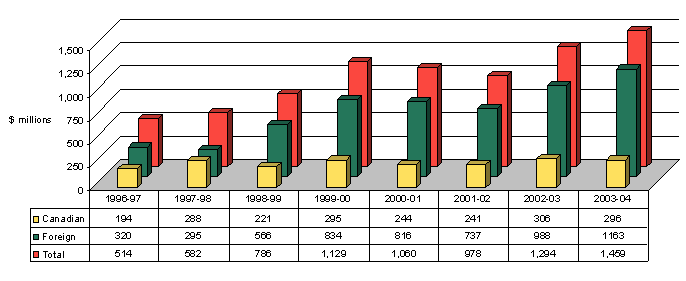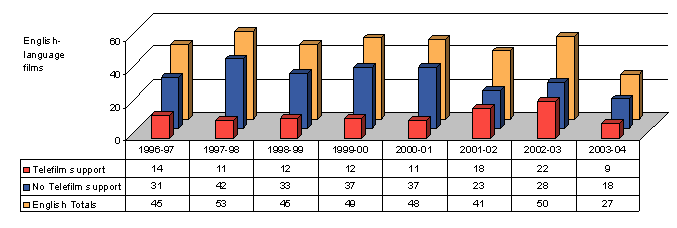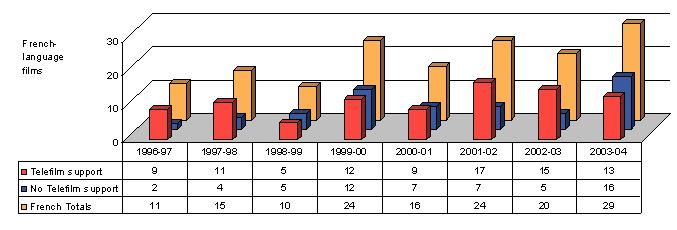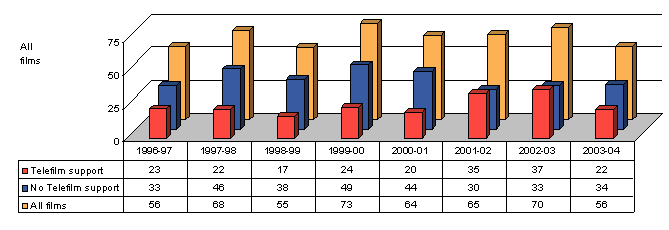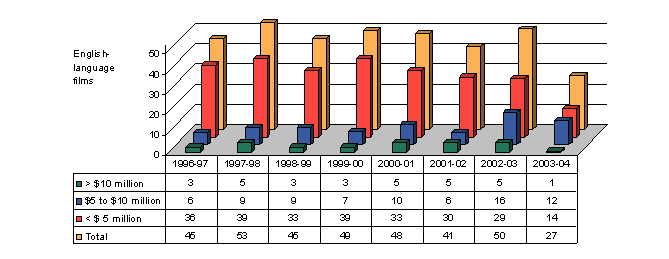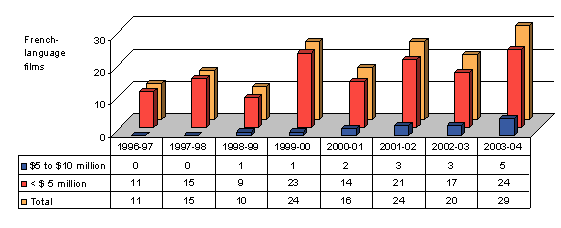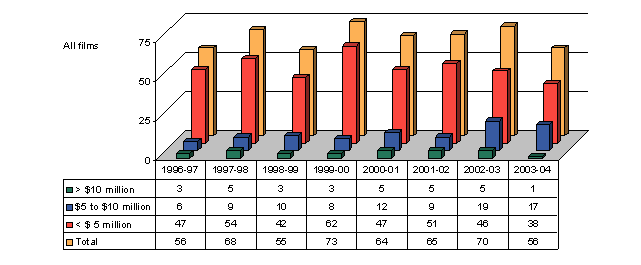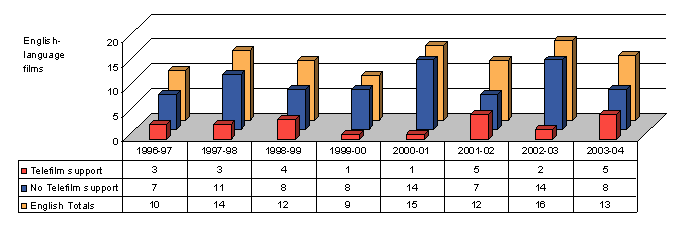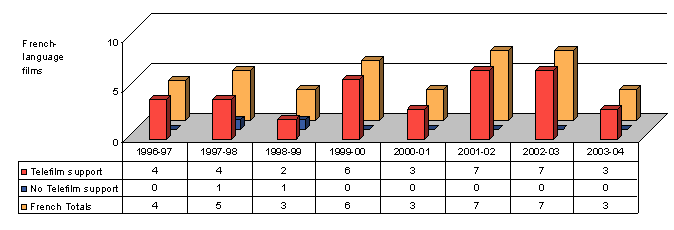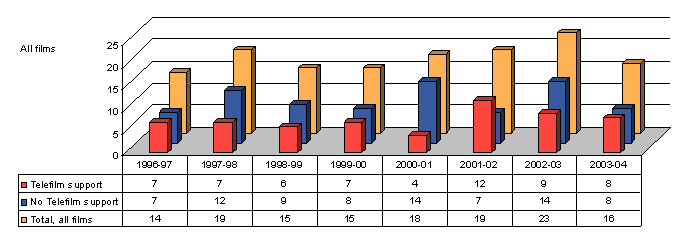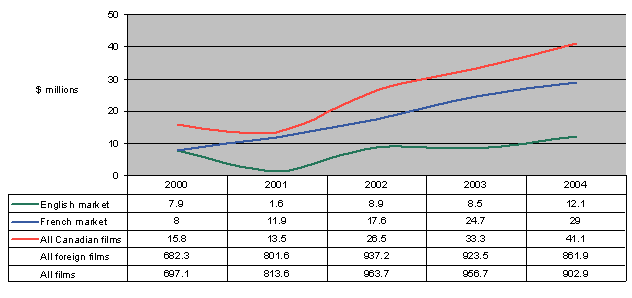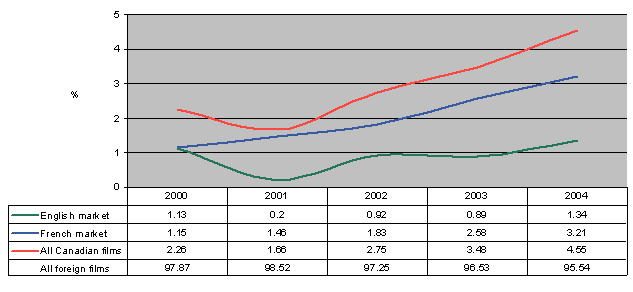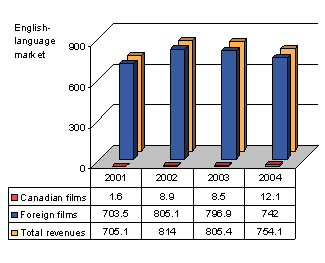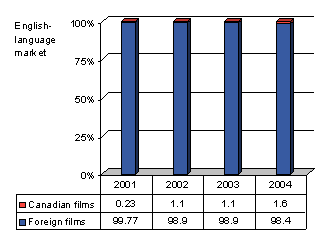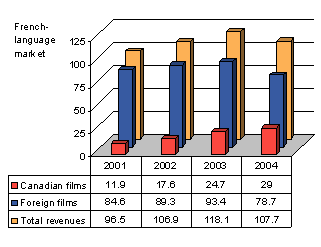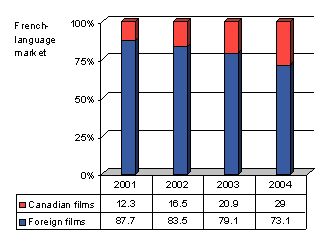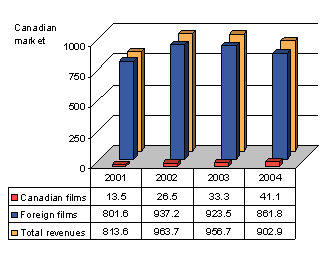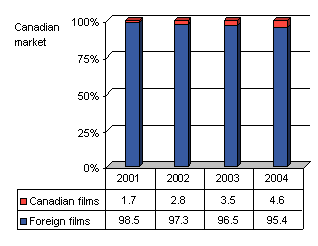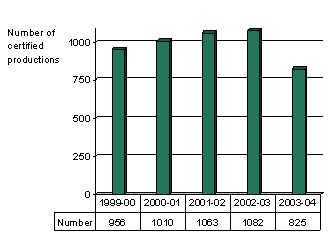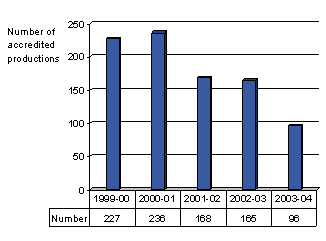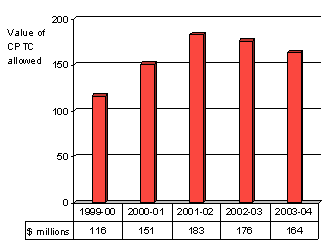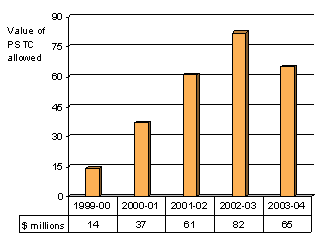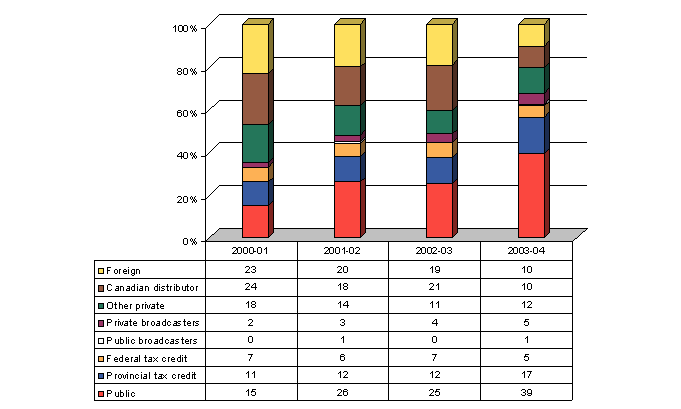CHPC Committee Report
If you have any questions or comments regarding the accessibility of this publication, please contact us at accessible@parl.gc.ca.
INTERIM REPORT ON THE CANADIAN FEATURE FILM INDUSTRY
The film industry is a vital component of Canada’s cultural sector and by some economic measures can be considered a success. For example:
| • | from 1996 to 2001, Canada’s feature film industry was the third largest cultural sub-sector in Canada in terms of Gross Domestic Product (GDP) generated; |
| • | over the past decade, more than 134,000 direct and indirect jobs have been created and production volumes (film and television) have doubled to nearly $5 billion annually, of which about two-thirds has been for the production of Canadian content; |
| • | between 1997-98 and 2002-03, attendance by Canadians to movie theatres rose from 99 million to 125 million paid admissions. |
The notable increase in movie attendance by Canadians is particularly interesting. In the 1950s many industry analysts predicted the demise of feature film thanks to the introduction of television. In the 1970s it was thought that the VCR would similarly jeopardize movie attendance. More recently — against the backdrop of ongoing innovations in technology such as the DVD, the PVR, video-on-demand, digital television and HDTV, peer-to-peer file sharing, and so on — there have been those who have worried that the feature film industry would find it harder to attract sizeable audiences. And yet despite this ever-increasing array of leisure time choices, Canadians have consistently flocked in large numbers to see feature films.
But challenges remain for Canada’s film industry. This is because box office receipts for the viewing of Canadian-made feature films have consistently represented a small fraction of the overall viewing of feature films. In fact, for many decades, the viewing of Canadian films remained stagnant at about 2%. Part of the challenge has been the long-standing global dominance of American feature films. This is why most film-producing countries outside the United States have, over time, introduced measures to encourage their respective domestic film production sectors.
Federal government support for the Canadian film industry has evolved over the years. During the first four decades following its creation in 1939 the National Film Board (NFB) was the primary outlet through which Canadians could obtain support for film production. The NFB’s mandate, however, was not designed to help grow Canada’s feature film industry, but to help train and assist documentary filmmakers in the production of films that would interpret Canada for Canadians and the world.
In 1967, with the creation of the Canadian Film Development Corporation (now Telefilm Canada), the government made its first foray into the development of a Canadian-owned and controlled feature film industry. Since that time, a long list of additional incentives have been offered, including capital cost allowances (1974 to 1995), film and video production tax credits (1995 to present), Canadian television production funding (1997 to present); training initiatives (1997 to present); and film and video production services tax credits (1997 to present). In parallel, most Canadian provinces have introduced tax credits or grants to attract film productions.
Canada’s first feature film policy was announced in 1988. The Film Distribution Policy, as it was known, was designed to encourage better market access for Canadian productions. A key element of this policy was the establishment of foreign investment policy guidelines under the Investment Canada Act that, among other things, prohibited foreign takeovers of Canadian-owned and controlled film distribution businesses. The policy also led to the creation of the Feature Film Distribution Fund, administered by Telefilm Canada for the development, production, distribution and marketing of Canadian feature films.
In 1998 the Department of Canadian Heritage launched a review of Canadian feature film policy. A discussion paper produced at that time noted that:
Despite the successes of the last 30 years, Canadian filmmakers still face formidable odds in bringing their works to movie audiences. The Government of Canada seeks to address this problem by initiating a review of its film policy. The Feature Film Policy Review will examine the challenges faced by theatrical films in Canada and will assist the Government in establishing priorities for action. The review will help set a course towards a future where more Canadians have access to Canadian films playing in their local cinemas — films that reflect their own locales, their own stories and their own culture.2
The culmination of the feature film review was the release of From Script to Screen — New Policy Directions for Canadian Feature Film in October 2000. This new policy marked “a major shift in the federal government’s support for Canadian film — from building an industry to building audiences”3 and identified the following objectives:
| • | to develop and retain talented creators; |
| • | to foster the quality and diversity of Canadian feature films; |
| • | to build larger audiences at home and abroad for Canadian feature films; and |
| • | to preserve and disseminate our collection of Canadian feature films for audiences today and tomorrow.4 |
The new Canadian feature film policy was designed to address each of these objectives by refocusing the investment of public funds — that would henceforth be distributed through a new mechanism known as the Canadian Feature Film Fund — on all stages of feature film production, from script development to the moment of theatrical release on screens across Canada. It also introduced a performance-based approach to the funding of Canadian producers and distributors and set “some ambitious goals,” most notably, the aim “to capture 5% of the domestic box office in five years and to increase audiences for Canadian feature film abroad.”5 To achieve this, the policy encouraged an increase in average production budgets to at least $5 million, and called for an increase in average domestic and international marketing budgets to at least $500,000.
Gauging the success of the 2000 feature film policy is a tricky undertaking. Since films typically take several years to conceive, fully fund, promote and release, data from the early 2000s are somewhat misleading as they represent productions that were triggered under the old policy. Nevertheless, in 2001-02, the first fiscal period following the introduction of the new policy, theatrical production in Canada was worth $978 million, of which $241 million was for Canadian productions. In 2003-04, the fiscal period for which the most recent data are available, the volume of theatrical production had increased to $1.46 billion, of which $296 million was for Canadian productions. During this same period overall box office receipts for domestic films rose from 1.7% in 2001 to 4.6% in 2004.
Despite these encouraging figures, there are those who assert that the Canadian feature film industry faces some serious challenges in the coming years. These challenges include:
| • | the relatively weak box office performance of Canadian films in the English-language market (in 2004, the French-language market was responsible for 70% of the total box office revenue earned by Canadian films); |
| • | the sustainability of the successes witnessed in the French-language market (more than 25% of all films viewed in Canada’s French-language market in 2004 were Canadian-made); |
| • | the decline in the overall number of foreign-location service productions (due to the strength of the Canadian dollar and the fact that some jurisdictions outside Canada now offer tax incentives similar to those offered by the federal government and the provinces). |
These concerns, and the many others that will be detailed in this report, help explain why the Standing Committee on Canadian Heritage decided in December 2004 to undertake a comprehensive study on the evolving role of the federal government in support of the Canadian feature film industry.6 Since that time the Committee has heard from more than 180 witnesses representing creators, producers, directors, exhibitors, distributors, writers, broadcasters, unions, as wells as both levels of government. It has also travelled to Winnipeg, Toronto, Montreal, Halifax and Vancouver to hold hearings and to conduct site visits.
The Committee recognizes that the Department of Canadian Heritage has recently launched its own five-year review of From Script to Screen. We do not, however, see our work as a duplication of effort. On the contrary, we are convinced that our study will serve to enrich and complement the work of the Department. After all, the mandate of the Standing Committee on Canadian Heritage is to oversee policies and legislation pertaining to the Canadian Heritage portfolio. It follows, therefore, that it is well within this committee’s mandate to monitor and report on the link between the Government of Canada’s support to the feature film industry and the success of its policy objectives to increase the availability of, and audiences for, Canadian feature films.
With the above considerations in mind, the purpose of this interim report is to briefly review what the Committee has heard since it launched its study on the present state of the feature film industry and its future prospects. It also spells out a process for the development of recommendations in collaboration with industry stakeholders, with a view to establishing a framework for a final report that will be tabled later this year.
In keeping with previous studies of this committee, the sections that follow are loosely divided along the following lines: creation, production, marketing, distribution, exhibition and next steps. While these categories are by no means mutually exclusive, they provide the flow needed to appraise the extent to which the feature film policy has succeeded in meeting its objectives to support Canadian film production “from script to screen.”
Before proceeding, it is useful to consider some of the available statistics on the current state of Canada’s feature film industry that are most relevant to this committee’s study of the feature film policy that was introduced in 2000.
Volume of Theatrical Production by Sector
Figure 1 shows the volume of theatrical production by sector for the period 1996-97 through 2003-04. Overall, the value of theatrical production activity in Canada grew by nearly 300% during this period, rising from $514 million to $1.46 billion.
This figure also shows the extent to which the value of Canadian feature film production fluctuated, ranging from a low of $194 million in 1996-97 to a high of $306 million in 2002-03. It further shows that during the last two fiscal periods since the introduction of the new feature film policy that the total value of Canadian film production was about $300 million each year.
|
Figure 1 |
Volume of theatrical film and television production, 1996-97 to 2003-04 |
|
Source: Canadian Film and Television Production Association, Profile 2005, p. 17. |
|
Perhaps the most interesting element of Figure 1, however, is the striking growth in the value of foreign location productions in Canada. In 1996-97 the total value of foreign location productions in Canada was $320 million; by 2003-04, this figure had reached an all-time high of $1.2 billion.
|
Foreign location shooting or production: |
CAVCO-Certified Canadian Theatrical Productions
The next figure provides added perspective on Canadian film production for the period 1996-97 through 2003-04. During this time frame the total number of film productions certified as “Canadian” by the Canadian Audio-Visual Certification Office fluctuated annually from a low of 55 to a high of 73.
|
CAVCO (Canadian Audio-Visual Certification Office) Certification: |
|
Figure 2 |
Number of CAVCO-certified Canadian theatrical productions by language and Telefilm certification, 1996-97 to 2003-04 |
|
|
|
|
|
|
|
Source: Canadian Film and Television Production Association, CAVCO data. |
|
One of the more interesting features of these data is the impressive rise in the number of CAVCO-certified French-language films, ranging from a low of 11 in 1996-97 to a high of 29 in 2003-04, and the sudden drop in the number of CAVCO-certified English-language films in the most recent reporting period. Indeed, between 1996-97 and 2002-03 about 40 to 50 English-language Canadian films received CAVCO certification in a typical year; in 2003-04, however, just 27 received certification.
According to the CFTPA’s Profile 2005 on the Canadian film and television industry, the decline in the number of CAVCO-certified productions can be explained by one or more of the following factors:
| • | a “weaker demand in international markets for foreign production including Canadian production,” which has, in turn, reduced potential levels of support for high cost productions;7 |
| • | an overall decline in co-productions with the United Kingdom and other European nations, many of whom have adopted tax incentives similar to those pioneered in Canada to encourage partnerships within Europe; |
| • | a migration by some Canadian filmmakers away from CAVCO-certification towards the Film or Video Production Services Tax Credit (PSTC) (described further down). |
Size of Financing for CAVCO-Certified Productions
Despite the drop in the number of CAVCO-certified (i.e., “Canadian”) productions in 2003-04 the total value of “Canadian” film productions was $296 million, down just $10 million from 2002-03 when CAVCO-certified productions were valued at $306 million (see Figure 1). This suggests that the size of the budgets for Canadian feature films — a key target of the new feature film policy — is on the rise. As Figure 3 shows, there has been a gradual increase in the size of feature film budgets in recent years in both linguistic markets. For example, in 1996-97, just 9 CAVCO-certified films had budgets of at least or greater than $5 million; in 2002-03, 24 films had budgets of at least or in excess of $5 million.
Figure 3 |
Size of financing for CAVCO-certified Canadian theatrical productions by language, 1996-97 to 2003-04 |
|
|
|
|
|
|
|
|
|
|
Source: Canadian Film and Television Production Association, CAVCO data. |
|
An important subset of the data presented in figures 2 and 3 is a category of films known as “treaty co-productions.” Canada has 49 co-production treaties with 53 countries. Since co-production treaties are based on the notion of reciprocity, about 50% of a co-production’s spending must be spent in Canada. Furthermore, for the purposes of Canadian-content certification, a treaty co-production, provided it meets the necessary criteria (e.g., a minimum level of creative input and financing for each of the co-producing countries), is automatically certified by CAVCO as a Canadian production.
Figure 4 shows the volume of Canadian feature-film treaty co-productions for the period 1996-97 through 2003-04, by language and Telefilm support.
|
Figure 4 |
Number of CAVCO-certified feature film treaty co-productions by language and Telefilm support, 1996-97 to 2003-04 |
|
|
|
|
|
|
|
Source: Canadian Film and Television Production Association, CAVCO data |
|
This figure reveals that the overall number of feature film treaty co-productions has fluctuated to some degree in recent years, with a low of 14 certified productions in 1996-97 and a high of 23 and 2002-03. It also shows that Telefilm support for treaty co-productions has been on the rise in recent times, with Canada’s French-language film producers being the principal beneficiaries of such funding.
Box Office Revenues and Market Share
Figure 5 shows Canadian box office revenues and market share by origin of film production for the past five reporting periods.
Figure 5 |
Box office revenues and market share by origin of production, 2000 to 2004 |
|
Source: Canadian Film and Television Production Association, Department of Canadian Heritage. |
|
This figure reveals that box office revenues for foreign films, of which the great majority were American-made, accounted for no less than 97% of all films viewed by Canadians between 1999 and 2003. There is some modest evidence, however, that the viewing of Canadian films in theatrical release is on the rise. In 2000, for example, the viewing of Canadian productions was a mere 2.3%; by 2004, this value was at 4.6%.
|
How are the English and French markets defined? |
Box Office Share by Linguistic Market
It is important to note that most of the growth in the Canadian market share in recent years can be explained by a rise in the viewing of Canadian films in the French market. Figure 6 shows Canadian film viewing by linguistic market for 2001 through 2003.
|
Figure 6 |
Box office revenues (in millions) and market share by linguistic market, 2000 to 2004 |
|
|
Box office revenues |
Market share |
|
|
|
|
|
|
|
|
|
|
|
|
|
|
Source: Canadian Film and Television Production Association, Department of Canadian Heritage. |
||
As can be seen, Canada’s French-language market witnessed a tremendous growth in the viewing of Canadian films during this period, with its market share more than doubling from 12.3% in 2001 to 26.9% in 2004. The English-language market during this same period also experienced some very modest growth, with a rise in the overall viewing of Canadian films from just 0.2% in 2001 to 1.6% in 2004.
Federal (and provincial) tax credits represent another important support element for feature film productions made in Canada. There are two types of federal tax credits: The Canadian Film or Video Production Tax Credit (CPTC) and the Production Services Tax Credit (PSTC). The CPTC is a refundable tax credit that refunds 25% of qualified labour expenditures incurred by a qualified film producer, net of any assistance, for the production of a CAVCO-certified Canadian film or video production. The PSTC reimburses 16% of qualified labour expenditures incurred, net of any assistance, by an eligible production company for services provided in Canada by Canadian residents or taxable Canadian corporations for the production of an accredited production (i.e., approved as eligible, but not “certified” as Canadian by CAVCO). In short, the PSTC is a purely industrial incentive designed to encourage filmmaking (by Canadians or foreigners) in Canada, whereas the CPTC is a cultural incentive that rewards those Canadians who are producing distinctly Canadian feature films.
Unfortunately, data on the total number of feature films that receive CPTC and PSTC support are difficult to obtain and are not normally disaggregated from support provided to Canadian television productions. Figure 7 presents data provided by CAVCO representatives when they appeared before the Committee.
|
Figure 7 |
Tax credit support to CAVCO-certified and CAVCO-accredited productions (film and television), 1999-2000 to 2003-04 |
|
|
Canadian Film or Video Production Tax Credit (CPTC) |
Production Services Tax Credit (PSTC) |
|
|
|
|
|
|
|
|
|
|
Source: CAVCO data (as reported by the Canada Revenue Agency) |
||
This figure shows that the number of film and television productions that received the PSTC tax credit varied from 236 in 2000-01 to 96 in 2003-04. The total value of such support ranged from $14 million in 1999-00 to a high of $82 million in 2002-03. As for the CPTC, the total value of support allowed for CAVCO-certified film and television productions has ranged in recent years from a low of $116 million in 1999-2000 to a high of $183 million in 2001-02. In 2003-04, financing for such productions stood at $164 million.
The overall importance of tax credits and other forms of government funding support for Canada’s feature film industry should not be underestimated. Figure 8 provides a breakdown of how CAVCO-certified theatrical productions were financed for the period 2000-01 through 2003-04.
|
Figure 8 |
Financing sources for CAVCO-certified Canadian theatrical productions, 2000-01 to 2003-04 |
|
|
|
|
Source: Canadian Film and Television Production Association, Profile 2005, p. 22. |
|
This figure demonstrates the extent to which Canada’s feature filmmakers have become dependent on financial support from both levels of government. In 2000-01, for example, about 15% of all support came from direct public funding support programs (such as Telefilm) and a further 18% came indirectly through federal and provincial tax credits. By 2003-04, nearly 40% of all financial support came from public programs and 22% was being raised through tax credits. This means that Canadian feature filmmakers now receive more than 60% of their production funding from government.
Another interesting development that can be seen in Figure 8 is the sudden drop in foreign funding support. In 1999-00, for example, 29% (not shown) of all financing for CAVCO-certified films came from foreign sources; by 2003-04, foreign contributions were down to just 10%. As noted earlier a weaker demand in international markets for Canadian productions helps explain some of this decline.
Other Data and Performance Measures
To this point, recent data on the volume of feature film production in Canada, the number of CAVCO-certified films, budget size, the number of treaty co-productions, box office revenues, market share for Canadian films and shifts in the type of funding sources have been presented. In several cases these data have been useful tools for gauging the extent to which certain objectives of the feature film policy have been met. For example, it was seen that:
| • | the overall market share for the Canadian feature film industry is closing in on the policy target of 5%; |
| • | Canadian films in the French-language market now enjoy a market share of more than 25%; |
| • | Canadian films in the English-language market continue to struggle, but audiences have increased very slightly, from a market share of 0.2% in 2001 to 1.6% in 2004; |
| • | production budgets have been on the rise and an increasing number are in fact above the $5 million threshold proposed by the policy; |
| • | box office revenues, although down overall in 2004, continue to climb for Canadian films8; and |
| • | public support for Canadian film production is more important than ever before. |
What these data cannot tell us, however, is anything about the extent to which Canadian films are being watched abroad or anything about other contexts (that is, outside Canadian cinemas) where Canadians are watching or have access to Canadian films. This is because data such as these are not collected in any systematic way.
The absence of such data coupled with a complete absence of any demographic data that describe those Canadians who do go to the cinema, poses a serious problem for a full appraisal of Canada’s feature film policy. Indeed, as this report will discuss later on, Canadian audiences now have access to Canadian films through many more sources than was once the case (e.g., DVD rentals and sales, pay-per-view, video-on-demand, through the Internet, etc). Regrettably, publicly available data on these sorts of viewing practices seem to be virtually non-existent.
Running in parallel with this challenge is the vague and subjective nature of certain policy objectives that lie at the very heart of the 2000 film policy. The policy, for example, seeks to “foster the quality and diversity of Canadian feature films.” But what performance measures can possibly be used to gauge such an objective?
On a related note, the policy places a singular emphasis on “filling cinemas with enthusiastic audiences for Canadian films.”9 But is this really the best method to reach Canadians? Is it realistic to be trying to reach Canadians through a cinematic infrastructure built by Hollywood for Hollywood films? This report will return to this question as well as the question of suitable performance measures later on. For now, it turns to a brief examination of what the Committee has heard to date about Canada’s feature film industry.
C. PRELIMINARY OBSERVATIONS ON WHAT THE COMMITTEE HAS HEARD
As noted earlier the Committee has heard so far from more than 180 witnesses. It has also received more than 80 submissions. What follows is not intended to be a comprehensive summary of what has been heard to date, but more of a reflection on key issues that have surfaced. The Committee recognizes many of the matters that are being raised require further and more in depth exploration. That said, it sees it as important to share with the film industry its preliminary observations on some of the core issues and constants that have being mentioned repeatedly since it launched its study this past February.
Creation, Production and Marketing
The creation and eventual exhibition of a feature film is a complex process involving the work of writers, producers, directors, actors and a host of important technical skills including lighting, set design, sound, photography, costumes and makeup to name only a few.10 However, witnesses told the Committee repeatedly that the most important element in a successful film is a story — the script.
The 2000 policy From Script to Screen recognized the importance of scriptwriting in part by suggesting that under the new policy more resources would be devoted to the development of scripts. The assumption being that the presence of more and better scripts would eventually lead to the creation of more successful Canadian feature films.
Of course, the creation of a screenplay, no matter how well done, does not guarantee the eventual success of a movie. There are other activities that are crucial to the creation of a successful feature film. The film must be produced and this requires that a producer pull together the financing for a film, and arrange for all the elements necessary to make the film (e.g., work with a director, photographer and so on). The producer also has to ensure that the film will be marketed, distributed and exhibited.
The steps involved in creation, production, marketing, distribution and exhibition are often described as the value-chain required for a successful movie. If one of the elements in the chain is not in place then the film will be far less likely to succeed.
The Committee heard many complaints about the “value chain” particularly as it applies to the creation and exhibition of English-language feature films. Although From Script to Screen recognized the importance of script development, a number of witnesses
pointed out very meagre resources were actually added to those available for script development. Indeed, the Screenwriting Assistance Component of the Canadian Feature Film Fund administered by Telefilm represents a mere $2.3 million of the Fund’s overall budget of $100 million.
Furthermore, although the policy recognizes the importance of the producer, a number of rules, regulations and requirements (e.g., of CAVCO and Telefilm) get in the way of producing and marketing films. Criticisms included:
| • | copyright requirements; |
| • | Telefilm clawbacks, the "grind;" |
| • | the absence/difficulty of bridge financing; |
| • | the delay in receiving payments for tax credits; and |
| • | the fixed timing of funding decisions each year. |
Telefilm’s decision-making process was another criticism that was raised repeatedly. There were two elements to this criticism: Telefilm’s historic tendency to disregard the importance of finding an audience and its failure to provide adequate marketing support.
Prior to the introduction of the new film policy, reaching audiences was not, and had never been, a criterion used by government funding organizations such as Telefilm Canada to determine which film projects would, or would not, receive funding; potential for success simply did not matter. This, in part, helps explain the poor track record for Canadian films (at least prior to 2000) in terms of attracting audiences in Canada and elsewhere. This also helps explain why a key objective of the new film policy is “to build larger audiences at home and abroad.” Indeed, as the Committee was told on several occasions, films do not really matter if no one ever sees them.
Just as witnesses criticized the level of funds available for script development and the decision making process, they also criticized the inadequate funds available for marketing. Although From Script to Screen recognized the importance of marketing, and there is some evidence that average marketing budgets have increased, there are still formidable difficulties involved in the marketing of English-language feature films.
English-language Canadian films compete in a North American market with hundreds of foreign (mostly American) films. A typical American film will have a marketing budget that equals or exceeds the cost of producing the film. If a film cost $30 million US to produce it will probably have a marketing budget close to $30 million US. Very few Canadian feature films have marketing budgets of more than $150,000 and most will have a marketing budget much smaller than this. The consequences of this is that many of the Canadian feature films funded by Telefilm in the past have not had an authentic theatrical release (that is, they did not appear in more than one or two cinemas, in part because they did not have a marketing budget to support their release).
Another consequence of the relatively low marketing budgets for English-language Canadian films is that very few Canadians have any awareness whatsoever that these films were ever made, let alone an opportunity to see them. As one witness told the Committee, even the most committed film buff has a hard time finding, let alone seeing, English-language Canadian films.
Another witness described the total box office for a number of English-language Canadian films in the past six months (to May 2005) as ranging from $144,000 to $14,000. If ticket prices are approximately $10, this means that the most successful film was seen by about 15,000 people, while others were seen by less than 2,000 people.
A number of witnesses also pointed out, however, that these difficulties do not apply to the marketing of French-language Canadian films, particularly in Quebec, where a vibrant “star system” has been successfully developed in recent years. The most important difference in the marketing of French-language films is that they are not competing with films from Hollywood. American films, it was noted, “under perform” in Canada’s French-language markets and since the market is so much smaller, the average marketing budget is more likely to provide the resources required to reach the potential French-language audience.
As noted earlier, an important issue when trying to measure the success of Canadian feature films has to do with clarifying French-language feature films have been a success, both individually (e.g., Les Invasions barbares) and as a whole (based on box office receipts); unfortunately, the same successes have not been witnessed in the English-language market.
One problem has to do with the fact that it is unrealistic to expect English-language films to compete with Hollywood blockbusters. After all, a typical blockbuster costs in the neighbourhood of $100 million US and in some instances will have a marketing and promotion budget worth more than the annual budget for the Canadian Feature Film Fund!
Given this economic reality several witnesses suggested to the Committee that the successes of French- and English-language Canadian films should be measured against independent films from around the world (in English and French and other languages). If this is so, we are confronted by the fact that there is a paucity of performance data on independent films (e.g., market share, average box office revenues and so on) with which to compare the success of Canadian feature films.
But if we are to compare the performance of Canadian films against the performance of foreign independent productions, a definitional problem surfaces. For example, although most people involved in the industry have an intuitive sense of what an independent film is — i.e., it is made by a producer (who probably controls the copyright) and is not working directly with a major studio — there are many different avenues by which film may come into being. This makes it very difficult to develop definitions that satisfy everyone. The American film Sideways, for example, is described as an independent film, but it was fully financed by Searchlight Pictures a division of 20th Century Fox. It is thought of as an independent film, however, because it is not a typical studio picture, is not a sequel and is not designed as a “franchise.” Clearly the classification of films presents a major challenge for those charged with developing more appropriate performance measures.
Creating and producing Canadian feature films is one thing. Getting those films viewed by Canadians is quite another. Film distributors play a crucial role in the chain between the creation of a film and it being seen by audiences. Distributors acquire the rights for the distribution of a film from the producer and ensure that it is promoted, marketed and exhibited. In some cases, a distributor may also choose to invest in a particular film. A distributor, therefore, is an essential component to the feature film industry in Canada.
To obtain the rights for distribution, a distributor will usually either pay the producer an advance on future revenues or give a guarantee of a fixed return. Distributors cover the costs of film prints and advertising and use their expertise to create a marketing strategy for the film. Distributors work closely with film exhibitors: box office admission revenues are shared between distributors and exhibitors on the basis of an agreed percentage. In addition to the release of the film in cinemas, distributors also plan, strategize and pay for the marketing and later release of the film on DVD or other format.
Because distributors are obliged to invest a great deal of money in a film prior to its release, it is in their best interests to ensure that film is seen by as large an audience as possible. For that reason, distributors are usually selective about the films they agree to take on for distribution and tend to assess the potential “success” of a film in terms of revenue return. This makes it very important for distributors to have in place a properly conceived distribution strategy well in advance of a film’s release.
As for exhibition, several witnesses raised the possibility of imposing screen quotas on exhibitors as a way to increase the visibility of Canadian film. That is, regulations should be enacted to oblige cinemas to screen a certain percentage of Canadian films.
These witnesses pointed to the success of Canadian content (“CanCon”) regulations requiring broadcasters in Canada to air a certain percentage of Canadian television shows on television or Canadian music on radio as a condition of their broadcasting licence. They argued that this success could serve as a model for similar CanCon requirements for showing Canadian films on cinema screens.
The federal government is able to legislate and regulate Canadian content on television and radio because it has the power to enact laws with respect to broadcasting under the Broadcasting Act. This power to regulate broadcasting comes from the Constitution Act, 1867, which reserves for Parliament the power to regulate “Lines of Steam or other Ships, Railways, Canals, Telegraphs, and other Works and Undertakings connecting the Province with any other or others of the Provinces, or extending beyond the Limits of the Province”.11 Over time this power has been determined to include broadcasting, since the airwaves are deemed to be a scarce public resource best regulated on a national basis.12
However, the licensing of films for distribution and exhibition of films in Canada is a matter of property and civil rights and as such falls wholly within provincial jurisdiction under section 92(13) of the Constitution Act, 1867.13 Any federal attempt to directly regulate film distribution and exhibition, therefore, will run afoul of this constitutional ordering. In short, Parliament simply lacks the constitutional capacity to enact laws mandating screen quotas for Canadian films.
That said, the federal government’s constitutional power to regulate trade and commerce as well as foreign investment does, in fact, offer one point of entry for the regulation of film distribution and exhibition in Canada. Since 1988 the Investment Canada Act has prohibited takeovers of Canadian-owned and controlled distribution businesses. Moreover, any newly established foreign-owned distribution businesses in Canada may only import and distribute proprietary products where the importer owns the “world rights” or is a major investor. This world rights distinction is important because American distributors typically only have control of the “North American” distribution rights.
Crucially, a number of foreign distributors — known collectively as “the U.S. majors” — are not subject to this policy because they were in operation prior to 1988. These major film distributors have been operating in Canada since the 1930s and at that time claimed Canada as part of their North American distribution territory. This historical fact resulted in these companies being allowed to continue their existing business practices despite the 1988 policy change set out in the Investment Canada Act.
The main production funding measures (i.e., Telefilm, the Canadian Television Fund, the Canadian Film or Video Production Tax Credit) for Canadian feature films require that those films be distributed by Canadian-owned and controlled distributors. This means that foreign distributors are not permitted to distribute Canadian feature films. In Canada, foreign-controlled companies may only distribute proprietary films. A proprietary film is one in which the distributor owns the world rights or is a major investor. Other foreign films must be distributed by a Canadian company other than the U.S. majors such as Paramount, Colombia or Universal that has acquired the rights to distribute any films in Canada.
As of 2004, 36 Canadian and foreign-owned distributors were active in theatrical distribution in Canada. Of these, eight member companies represent the large Canadian film distribution firms and there are eight major American distributors. Figure 9 shows the share of the Canadian box office by Canadian and foreign-controlled distributor for the years 2001 and 2004. As can be seen, the dominant Canadian distributor during both periods was Alliance, with a market share of 14.1%. Overall, however, nearly 75% of all films distributed in Canada in 2001 and in 2004 were distributed by foreign-controlled companies.
Figure 9 |
Share of total Canadian box office revenues by individual distributor, 2001 and 2004 |
|||||||||
2001 |
2004 |
|||||||||
Distributor |
Revenues |
% share of |
Number of |
Distributor |
Revenues |
% share of |
Number of |
|||
|
Warner Bros |
129.8 |
16.0 |
33 |
Warner Bros |
130.9 |
14.5 |
37 |
|||
|
Canadian-controlled |
178.7 |
22.0 |
341 |
Canadian-controlled |
225.1 |
24.9 |
377 |
|||
|
Foreign-controlled |
634.8 |
78.0 |
161 |
Foreign-controlled |
677.8 |
75.1 |
189 |
|||
|
Total |
813.6 |
100.0 |
502 |
Total |
902.9 |
100.0 |
566 |
|||
Source: Department of Canadian Heritage |
In red – |
Canadian-controlled distributors |
||||||||
Concerns that the U.S. majors possessed an unfair business advantage led the Competition Bureau in 2000 to investigate the distribution and exhibition of feature films in Canada. Some film exhibitors alleged that the major film distributors, as well as major film exhibitors, engaged in anti-competitive practices. These allegations included:
| • | insisting that the major distributors supply the major exhibitors with exclusive licenses to exhibit films; |
| • | that major exhibitors used their market power to pressure distributors not to supply licenses for commercially valuable motion pictures to independent exhibitors; and |
| • | that the major exhibitors individually align themselves with their own group of major distributors to the exclusion of other exhibitors. |
Through the above arrangements with major distributors, the major exhibitors get a right of first refusal over licenses for motion pictures. It was alleged that the overall effect of these practices was to substantially lessen and prevent competition in markets for film exhibition in Canada.
The Competition Bureau conducted an investigation into these allegations with a view to determining whether the practices amounted to a breach of the Competition Act, section 75 (refusal to supply) or section 79 (abuse of dominant position). The Bureau noted that distributors hold the copyright to license their motion pictures in Canada. However, a licence is not a product as the term is used in section 75 of the Act. Therefore, the Bureau determined that it could not pursue the complaints from exhibitors under section 75 of the Competition Act.
Turning to the question of possible abuse of dominant position, during its review the Bureau noted that certain major distributors appeared to have a preference for dealing with either one of the two major film exhibitors, and that it is generally the practice of distributors to license a motion picture to only one exhibitor in a local area or “zone”. Nevertheless, taking into consideration the large number of films distributed throughout Canada in the five year period considered, the Bureau concluded that the evidence available was not sufficient to support the allegation that the major film exhibitors successfully pressured motion picture distributors to not supply independent exhibitors.
Witnesses who appeared before the Committee identified a number of challenges facing the distribution and exhibition of Canadian feature films. Chief among these is the presence and strength of the U.S. majors and their effect on what films are seen and for how long. Control of the distribution systems translates powerfully into control of the films that are seen. Distributors make business decisions focusing on maximizing revenues and in general it is large Hollywood blockbuster-type films that generate the most revenue. Any film that does not create a sufficient amount of box office revenue is simply pulled from the screens.
Moreover, a Canadian feature film that may be grossing better than the other films that are playing at the time may be pulled in favour of another film that is perceived to be a potential blockbuster. This lack of screen space and time, together with an inability to compete with large American corporations, is a source of considerable frustration.
As mentioned earlier, because of their investment in films prior to their being released, it is in a distributor’s best interests that a film be seen by as large an audience as possible. Distributors are therefore very selective about the films they undertake for distribution. This, combined with the limited number of Canadian distributors, has led some to consider those Canadian distributors to be “gatekeepers” with the power to decide which projects go forward and which do not. This is a considerable concern: absent a distribution deal with a Canadian distributor, Canadian producers are unable to get access to public funding for their projects.
Additionally, distributor selectivity can create a certain “comfort zone” beyond which a distributor is reluctant to venture. This leads to a tendency to adhere to a formula believed most likely to lead to financial success, which may reinforce the status quo, to the detriment of distributors and films that lie outside this comfort zone.
An additional area of concern was the amount of money made available to Canadian distributors for the distribution and promotion of Canadian feature films. While there are numerous incentives for the creation and production of feature films in Canada, there is less emphasis on help with the distribution. Given the hegemony of the U.S. majors and the money they are able to put into distribution and promotion, it is a considerable challenge for Canadian distributors to get their films noticed. Canadian distributors are seen to lack the clout that U.S. distributors have with their affiliated exhibitors.
As well, distribution and marketing budgets and plans sometimes appear as afterthoughts rather than being an integral part of the creation and production process. This appears to highlight a need for greater awareness of marketing and promotion as a key policy element for the distribution of Canadian feature films. It also reinforces the importance of having a well-conceived marketing and distribution strategy in place prior to a film’s release.
Related to financial concerns is the issue of accountability. While agencies such as Telefilm and others require a distribution and marketing plan, some concern was expressed with respect to the fact that there appears to be little way to ensure that distributors follow through on those plans. It was therefore suggested that Telefilm and other federal agencies that provide funding and support be able to hold distributors accountable for legitimate and viable marketing and promotion plans.
Currently, only Canadian-owned and controlled distribution companies may distribute Canadian films. In order to obtain public funding for production projects, producers are obliged to align themselves with Canadian distributors only. As noted, this field lacks the financial resources available to foreign — and especially American — distributors. Thus Canadian producers must opt between government incentives or a broader choice of distributors.
It was suggested by witnesses that if Canadian producers were able to deal with those foreign distribution companies that have access to the Canadian market (i.e., the U.S. majors) this would broaden the pool of companies to which producers could pitch their projects. This in turn would increase competition and could lead to increased levels of public-private funding over time.
Lastly, a further problem with distribution relates to the physical distribution of film and the wear and tear on the film itself as a result of this process. Presently, prints of analog films are made for physical distribution to individual cinemas. Each film is replayed in cinemas numerous times before being distributed to the next cinema in line, which plays it numerous times and then passes it along to the next cinema and so on. Cinemas that do not receive first copies of a film are obliged to wait until a copy is available to them. Moreover, each showing of the film degrades its slightly so that the further down the line a film is the less perfect its quality.
E-cinema, short for “electronic cinema”, represents a new technology that could substantially change the way films are distributed in Canada and elsewhere. Using digital technology, it is a way in which films may be distributed in a much more cost-effective manner.
Currently, analog (non-digital) films are printed and then individually distributed to individual cinemas. Oftentimes Canadian films cannot be launched in many cinemas because it costs so much to make analog prints. The process of playing, replaying and then sending the film to the next cinema in line leads to the degradation of the film as mentioned earlier. This process also obliges some cinemas to wait their turn in line to receive a given film.
Digital distribution avoids these problems. Digital reproductions are virtually perfect from the first copy to the thousandth copy. Moreover and as importantly, material in digital form may be easily and broadly distributed. A film in digital form can be distributed to numerous cinemas simultaneously with no loss in quality and at a reduced cost. The attraction of this new form of film distribution is obvious.
It is not, however, without its problems. It is not enough to have a film in electronic format that can be distributed electronically; the receiving cinema must be appropriately equipped to show digital films. The start-up costs to switch from an analog to a digital cinema can be very expensive for many cinemas and prohibitive for almost all small independent ones. Currently Canada has fewer than a dozen digital exhibition screens, while the United Kingdom already has 50 and The Netherlands is also very active in this area.
Although this report has discussed the importance of a “theatrical release” for a film and witnesses stressed a number of areas that need to be improved it is important to realize that a theatrical release in 2005 does not have the same relation to the total audience or revenue for a film that it did in the 1950s. In the early 1950s 100% of a film’s revenue would come from the theatrical release. This is no longer the case. Revenues now come from the sale and rentals of DVDs, pay-per-view and the sale of television rights. A recent article in the Wall Street Journal suggested that for many films theatrical release was both an important part of the overall marketing strategy and often a revenue source of only 20% of what a film might earn.14
These changes in what might be called the “ecology” of film have not been fully recognized by the 2000 feature film policy. The larger portion of the audience for most Canadian films is probably television viewing and through the sale or rental of DVDs and videos. Certainly the television audience for a film is likely to be much higher than the few thousand that might have seen the film in its theatrical release.
For these reasons, and others, assessing the success of From Script to Screen only in terms of the success of the theatrical release of a film is probably unwise. This is not to deny the integral role of theatrical release, only to suggest that theatrical release is merely one of a number of sources for Canadian audiences for Canadian films.
Indeed, although the core elements of this study have to do with Canada’s feature film industry it is abundantly clear to the Committee that the feature film industry has important links to both Canada’s broadcasting system and the production of non-Canadian films (foreign shooting) in Canada. The skills required to produce television drama or to work with foreign producers are the very skills that one needs to have a healthy and viable Canadian film industry.
Witnesses also raised questions about the focus of the 2000 policy on feature films to the exclusion of long-form, feature length documentaries. They pointed out that documentaries have long been a Canadian strength and a narrow definition of feature film (i.e., one that excludes long form documentaries) acts to weaken a Canadian strength.
An interim report, by definition, cannot be complete. The Committee is well aware there are gaps in its presentation of the issues that it has heard to date. This does not mean, however, that it is insensitive to the full range of issues that have been raised. For example, this report has not addressed:
| • | the definition of “feature film”; |
| • | the importance of cultural diversity; |
| • | the contribution of foreign location service productions to the Canadian feature film industry; |
| • | copyright and intellectual property rights; |
| • | the importance of federal tax credits; |
| • | the importance of provincial support measures; |
| • | conservation and preservation; |
| • | the growing importance of short and long-form documentaries; |
| • | the role of training schools; |
| • | audio and sound mixing; |
| • | dubbing and subtitling; |
| • | the ownership of exhibitors and distributors; |
| • | the role of Telefilm Canada; |
| • | the role of the Canadian Television Fund; |
| • | the role of the CRTC; |
| • | the role of Canada’s public and private broadcasters; |
| • | the role of the Competition Bureau; |
| • | the overall structure of the financing system; |
| • | the role of Canadian and international film festivals; |
| • | the role of Canada’s trade commissioners, embassies and consulates; |
| • | developments in new technologies and innovative new distribution methods (e.g., e-cinema and d-cinema); and, |
| • | policy approaches, funding strategies and tax structures in non-Canadian jurisdictions. |
Furthermore, a more in-depth analysis of recent hearings held in the Western and Atlantic regions remains, and additional consultations with industry stakeholders and government are required.
Notwithstanding the many issues that have not been addressed, the Committee is convinced that it has received sufficient input to issue a call for a second round of submissions. In the next stage of its work, the Committee would like to focus on the questions found in Appendix B.
The Committee is of the view that the first round of its work (February to June 2005) has allowed it to develop an understanding of the core issues facing Canada’s feature film industry. During the second phase of its work, which it intends to launch as soon as Parliament resumes in September 2005, it would like to focus on the questions raised in Appendix B. This second round may not involve hearings, but does require input from industry stakeholders. For this reason, the Committee calls on interested parties to submit before 15 September 2005 their response (or responses) to those questions that apply. Please note that there is no need to respond to all of the questions listed.
The Committee further notes that responses should not take the form of a traditional brief. With this in mind, it stresses that:
| • | Responses should be clear and concise and propose specific language that could be used for the development of recommendations to address particular issues related to Canada’s feature film industry. |
| • | Each recommendation should be followed by a short paragraph that describes or justifies the advantages and disadvantages that might flow from any proposed changes. |
| • | No assumption should be made that additional resources will be made available; recommendations should make every effort to work within the available funding envelopes. |
The Committee looks forward to the next phase of its study and thanks all of those who have made contributions to date.
| 2 | A Review of Canadian Feature Film, Discussion Paper, Department of Canadian Heritage, February 1998, p. 1. |
| 3 | From Script to Screen — New Policy Directions for Canadian Feature Film, Government of Canada, October 2000, p. 1. |
| 4 | Ibid. |
| 5 | Ibid. |
| 6 | See Appendix A for the Terms of Reference for the Committee’s study. |
| 7 | CFTPA, Profile 2005, An Economic Report on the Canadian Film and Television Production Industry, p. 11. |
| 8 | Box office revenues are affected by the number of paid admissions as well as increases or decreases in ticket price. A more considered discussion of these variables will be undertaken in the Committee’s final report. |
| 9 | From Script to Screen — New Policy Directions for Canadian Feature Film, Government of Canada, October 2000, p. 5. |
| 10 | The education and training of these people is an important element of a comprehensive film policy. However, it is not dealt with directly in Script to Screen, and so is not dealt with in this interim report. However, education and training will be an important section of the Committee’s final report. |
| 11 | Constitution Act, 1867, s. 92(10)(a). |
| 12 | See, for example, Radio Reference [1932] A.C. 304. |
| 13 | Re Nova Scotia Board of Censors et al and McNeil (1978), 84 D.L.R. (3d) 1. |
| 14 | “Today a movie’s run in the theatres is really a marketing campaign for the movie-affiliated products to come. … Fifty years ago, a movie’s run in the theatres accounted for all of the revenue to the studio; now it makes up less than 20%.” Wall Street Journal, Jessie Eisinger — “Weekend Box Office Isn’t the Ticket,“ Wednesday, May 25, 2005, p. C1. |
